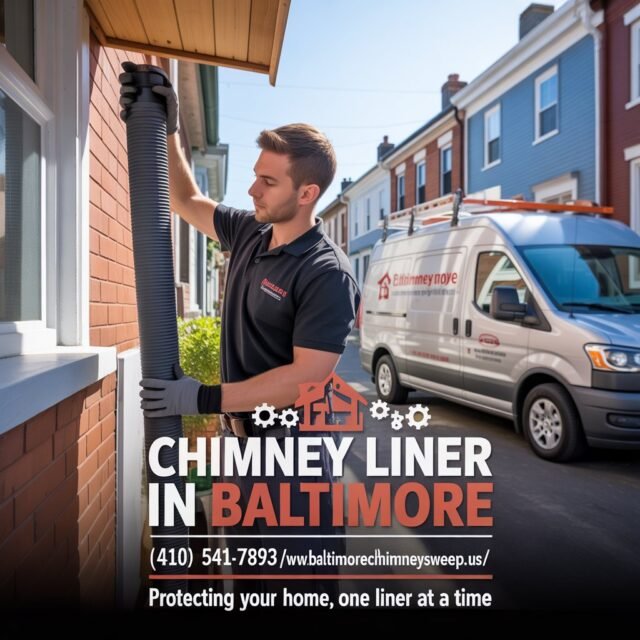If you own a home in Baltimore with a fireplace, wood stove, or fuel-burning appliance, you’ve probably heard someone mention chimney liners. They might not be the flashiest part of your home, but these hidden workhorses play a major role in keeping your chimney safe, efficient, and up to code.
So, what exactly is a chimney liner in Baltimore, and how do you know which one is right for your home? Whether you’re installing a liner for the first time or replacing an old one, let’s walk through the types, costs, key features, and most importantly how to choose the best fit for your situation.
What Does a Chimney Liner Actually Do?
Think of your chimney liner like the exhaust pipe in a car. Its job is to safely carry smoke, heat, and combustion gases out of your home while protecting the masonry from high temperatures and corrosive chemicals.
In short, the liner:
- Prevents chimney fires by containing high heat and preventing it from reaching flammable framing
- Improves efficiency by helping your appliance draft properly
- Protects brick and mortar from creosote, moisture, and acidic gases
- Keeps toxic gases like carbon monoxide from seeping into your living space
In Baltimore, where weather conditions swing from humid summers to icy winters, a proper liner can also help prevent freeze-thaw damage inside your chimney.
Types of Chimney Liners (And Which One’s Right for You)
Not all chimney liners are created equal. The material you choose depends on what you’re burning, the shape of your flue, and your budget. Here’s a breakdown of the most common options:
| Liner Type | Best For | Key Features | Approx. Cost (Installed) |
| Clay Tile | Traditional fireplaces | Durable, long lifespan, lower cost | $2,000–$4,000 |
| Stainless Steel | Wood, gas, or pellet stoves | Flexible, corrosion-resistant, safe | $2,500–$5,500 |
| Aluminum | Gas appliances only | Lightweight, affordable, less durable | $1,000–$2,500 |
| Cast-in-Place | Older or irregular chimneys | Insulated, long lifespan, custom fit | $4,000–$7,000+ |
Clay Tile Liners
These are the traditional choice and are often found in older Baltimore homes. They’re affordable and can last decades if properly maintained. However, they’re harder to repair, don’t work well with modern gas appliances, and may crack under extreme heat changes.
Stainless Steel Liners
These are the most popular modern option. They come in rigid or flexible designs and are perfect for wood-burning stoves, pellet appliances, and fireplaces. They’re corrosion-resistant and meet safety codes across Baltimore County. Bonus: they’re often insulated, which improves draft and reduces creosote buildup.
Aluminum Liners
These are only for gas appliances and only in very specific conditions. They’re not meant for wood or oil and don’t stand up well to high temperatures. Use with caution and only if a certified pro says a chimney liner for gas appliances is suitable.
Cast-in-Place Liners
This is more of a custom solution. A special cement-like material is poured inside the flue to create a solid, seamless liner. It adds structural support, so it’s a good fix for chimneys in rough shape. Not cheap, but very effective for long-term durability.
Safety First: Why a Good Liner Matters
Living in Baltimore, you probably use your heating system often through the colder months. A damaged or missing liner can lead to some serious risks:
- Chimney fires: Without a liner, extreme heat can crack brickwork or ignite nearby framing
- Carbon monoxide leaks: Damaged liners can allow toxic fumes to seep into living areas
- Code violations: Baltimore City codes require properly sized, UL-listed liners for most appliance types
- Creosote buildup: Wood smoke without a liner creates more sticky residue, increasing fire risk
If you’re converting your fireplace to a pellet stove or upgrading to a high-efficiency gas furnace, you’ll also need to resize the liner to match the new appliance. An oversized or undersized liner leads to poor draft and carbon buildup.
Cost Breakdown & What to Expect
Liner installation isn’t exactly a quick DIY job it requires special tools, knowledge of chimney physics, and often permits or inspections depending on where you live in Baltimore.
Here’s a rough idea of what you might pay:
- Stainless steel liner (average job): $3,000
- Clay tile liner replacement: $3,500
- Gas liner retrofit (aluminum): $1,800
- Custom cast-in-place: $6,000–$8,000
Installation usually takes a full day, sometimes more if the chimney needs repair first. Most companies include a Level 2 chimney inspection before beginning work.
A Real Baltimore Example
“After years of patching cracks in our clay liner, we finally had a stainless steel liner installed in our rowhome near Canton,” says homeowner Laura T. “It made a huge difference. Our wood stove runs smoother, and I feel safer using it. Wish we’d done it years ago.”
Her story is common: people often wait too long to replace an aging liner because it’s out of sight. But when done right, it’s one of the smartest upgrades you can make to a chimney system especially in older brick homes scattered across Baltimore’s historic neighborhoods.
Final Thoughts: Which Liner Should You Choose?
There’s no one-size-fits-all answer, but here’s a quick summary:
- Go with clay if you’re on a tight budget and have a traditional open fireplace
- Choose stainless steel for modern wood or pellet stoves, or if you’re upgrading your system
- Use aluminum only for basic gas appliances and when local codes allow
- Opt for cast-in-place if your chimney is deteriorating or oddly shaped
If you’re still unsure, don’t guess get a chimney sweep or certified technician to inspect your system. They’ll help match the liner to your appliance and local building codes, especially since Baltimore has strict fire safety guidelines.
Read More: Chimney Sweep




